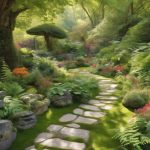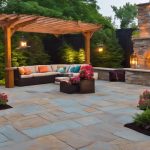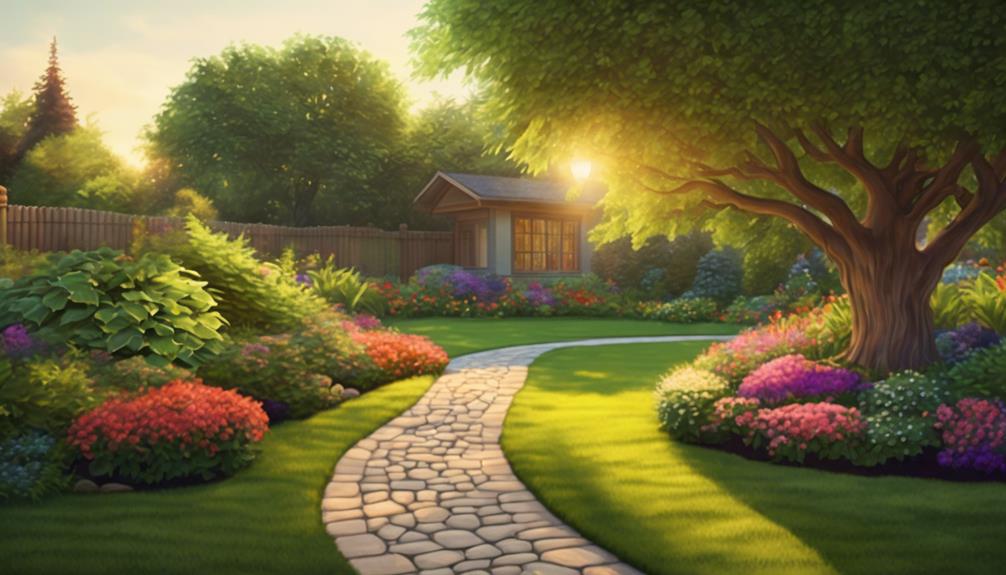
Enhance Your Garden With Custom Stone Pathways
20 October 2024
How to Install Outdoor Patios With Hardscaping
20 October 2024Homeowners can maintain their hardscaping by following simple yet effective strategies.
Regularly sweep and pressure wash surfaces to remove debris and dirt. Inspect pavers for cracks or shifting stones, and reseal joints to prevent weed growth and moisture infiltration.
Seasonal maintenance is vital; apply sealers during appropriate weather to protect against the elements. Implementing drainage solutions helps mitigate soil erosion and standing water.
Moreover, consider planting ground cover or using mulch to suppress weeds.
These practices not only extend the lifespan of hardscaping materials but also improve property aesthetics. Discover more tips to keep your outdoor spaces looking their best.
Hardscaping Maintenance Essentials
Maintaining hardscaping involves consistent attention to both cleaning techniques and seasonal repairs.
Regular cleaning helps preserve the aesthetic and integrity of materials, while a seasonal repair checklist ensures that any issues are promptly addressed.
Regular Cleaning Techniques
Regular cleaning is crucial for preserving the aesthetic and functional integrity of hardscaping features around your home.
To maintain surfaces such as patios, driveways, and pathways, begin by sweeping away debris and leaves, which can trap moisture and promote mould growth.
For concrete and stone surfaces, utilise a pressure washer to effectively remove stains and grime; ensure you adjust the pressure to prevent damage.
For more delicate materials, a soft-bristle brush with a mild detergent solution will suffice.
Regularly inspect joints and seams for weeds or grass, and remove them promptly to prevent root growth.
Furthermore, applying a sealant to porous surfaces post-cleaning can improve durability and reduce future maintenance efforts, guaranteeing lasting beauty and functionality.
Seasonal Repair Checklist
As the seasons change, homeowners should prioritise a thorough inspection of their hardscaping features to identify and address any necessary repairs.
Begin with an assessment of paver integrity; check for cracks or shifting stones that may require re-levelling.
Inspect retaining walls for signs of erosion or bulging, ensuring drainage systems are functioning correctly to prevent water damage.
Pay attention to any joints or seams in concrete surfaces, as they may need resealing to prevent moisture infiltration.
Furthermore, evaluate the condition of pathways and patios for unevenness or surface wear.
Lastly, consider revitalising any faded sealants or coatings to improve durability and aesthetics.
Regular adherence to this seasonal checklist will extend the life of your hardscaping investments.
Seasonal Weather Considerations
Seasonal weather changes can significantly impact the integrity of hardscaping features, making it essential for homeowners to implement effective maintenance strategies.
Key considerations include soil erosion prevention techniques, regular sealing of surfaces to protect against moisture and temperature fluctuations, and consistent joint filling maintenance to ensure durability.
Soil Erosion Prevention Techniques
Implementing effective soil erosion prevention techniques is crucial for homeowners, especially considering the varying impacts of seasonal weather conditions.
Erosion can significantly compromise the integrity of your hardscaping, leading to costly repairs. To safeguard your property, consider the following strategies:
- Plant Ground Cover: Establishing dense ground cover can absorb rainfall and minimise runoff, thus protecting soil integrity.
- Install Retaining Walls: These structures can efficiently hold back soil and reduce erosion on slopes.
- Utilise Mulch: Applying a layer of mulch can help retain moisture and prevent soil displacement during heavy rains.
- Create Drainage Solutions: Proper grading and drainage systems will redirect water flow, minimising erosion risks.
Regular Sealing of Surfaces
Regular sealing of hardscaping surfaces is essential for maintaining their durability and appearance, particularly in regions that experience extreme weather fluctuations.
Proper sealing acts as a protective barrier, preventing moisture infiltration and damage from freeze-thaw cycles.
To guarantee peak performance, consider the following seasonal weather considerations:
- Spring: Seal after winter to combat water damage from melting snow.
- Summer: Protect against UV rays that can degrade sealants and surfaces.
- Autumn: Seal before leaves fall, preventing staining and accumulation.
- Winter: Reapply as necessary, ensuring surfaces withstand icy conditions.
Regular Joint Filling Maintenance
While maintaining the integrity of hardscaping surfaces, attention to joint filling is crucial, especially as weather conditions change throughout the year.
Seasonal fluctuations can exacerbate wear and tear on joints, leading to unsightly cracks and compromised stability. To ensure ideal maintenance, consider the following:
- Spring: Inspect for erosion caused by melting snow and rain. Refill joints promptly to prevent further damage.
- Summer: Protect against heat-induced shrinkage by using flexible joint fillers that can adapt to temperature shifts.
- Autumn: Clear debris from joints to prepare for winter, ensuring that water doesn't freeze and expand within cracks.
- Winter: Monitor for ice formation; apply sand to joints for traction and reduce freeze-thaw cycles.
Mastering these seasonal considerations will greatly improve the longevity and aesthetics of your hardscaping.
Tools for Effective Maintenance
To maintain hardscaping effectively, homeowners must initially gather essential maintenance tools tailored to their specific needs.
Regular inspections and cleaning are vital in preventing long-term damage, while understanding advanced paver restoration methods can significantly prolong the lifespan of outdoor surfaces.
Gather Necessary Maintenance Tools
A well-equipped toolkit is essential for effective hardscaping maintenance, ensuring that homeowners can tackle multiple tasks with ease and efficiency.
Investing in the right tools not only enhances performance but also allows homeowners to take pride in their outdoor spaces.
Consider including the following important items in your toolkit:
- Pressure Washer: Revitalise surfaces and remove stubborn debris effortlessly.
- Weed Torch: Efficiently eliminate unwanted vegetation without harmful chemicals.
- Paver Sealer: Protect and enhance the beauty of your hardscaping investments.
- Joint Sand Applicator: Maintain the integrity of your paving stones by sustaining joint stability.
Routine Inspection and Cleaning
Regularly inspecting and cleaning hardscaping features is crucial for maintaining their longevity and aesthetic appeal.
A proactive approach not only preserves the beauty of your outdoor spaces but also prevents costly repairs in the future.
Equip yourself with the right tools and techniques to ensure effective maintenance.
Consider the following essentials:
- Pressure Washer: To remove stubborn dirt and grime, restoring your surfaces to their original luster.
- Broom and Dustpan: For regular debris removal, preventing damage and ensuring safety.
- Joint Stabiliser: To maintain the integrity of paver joints and minimise weed growth.
- Sealer: Protects surfaces from stains and weathering, extending their lifespan.
Advanced Paver Restoration Methods
Maintaining the beauty and functionality of paver surfaces often requires more than routine cleaning and inspection.
Advanced restoration methods can rejuvenate your hardscaping, ensuring it remains a stunning focal point of your property. Employing the right tools and techniques is crucial for achieving ideal results.
- Paver Sealer: Protects against stains and UV damage, enhancing colour vibrancy.
- Joint Sand: Resilient materials fill gaps, preventing weed growth and erosion.
- Pressure Washer: Deep cleans surfaces, effectively removing stubborn dirt and grime.
- Concrete Resurfacer: Restores worn pavers, providing a fresh, smooth finish.
Utilising these advanced methods will not only extend the life of your pavers but also enhance the overall aesthetic of your outdoor space.
Increased Property Value Retention
Investing in hardscaping not only enhances the aesthetic appeal of a property but also significantly contributes to its long-term value retention. Well-maintained hardscaping features, such as patios, pathways, and retaining walls, improve the functionality and usability of outdoor spaces, making properties more attractive to potential buyers.
| Aspect | Impact on Value | Maintenance Importance |
|---|---|---|
| Curb Appeal | High | Regular Cleaning |
| Durability | Sustained | Prompt Repairs |
| Functionality | Increased Demand | Seasonal Upkeep |
A strategic approach to hardscaping maintenance ensures that your property remains competitive in the real estate market, safeguarding your investment over time. Prioritising these elements will not only enhance enjoyment but also solidify property value retention.
Garden Design and Layout
Effective garden design and layout are crucial for enhancing the overall aesthetic and functionality of outdoor spaces.
Key elements such as patio design improvements, paver colour enhancement techniques, and proper sealant application can significantly contribute to a cohesive and visually appealing environment.
Patio Design Enhancements
In the realm of enhancing your patio design, careful planning can transform an outdoor space into a functional and aesthetically pleasing extension of your home.
To achieve excellence in patio improvements, consider the following elements:
- Strategic Layout: Design your patio to optimise flow and accessibility, creating distinct zones for dining, lounging, and entertaining.
- Material Selection: Choose high-quality materials that complement your home's architecture, ensuring durability and visual appeal.
- Integrated Lighting: Incorporate ambient and task lighting to extend usability into the evening while improving mood and atmosphere.
- Natural Elements: Introduce planters or vertical gardens to soften hardscapes, fostering a harmonious blend between nature and the built environment.
Paver Color Enhancement Techniques
Enhancing the aesthetic appeal of your outdoor space often extends beyond the layout and materials of your patio; the colour and finish of pavers play a significant role in garden design and layout.
To boost the vibrancy and visual impact of your pavers, consider the following techniques:
- Dye Application: Utilise specialised dyes to infuse life and depth into the existing colour of your pavers.
- Staining: Apply stains to achieve a rich, textured appearance that complements your landscape.
- Colour Washing: A subtle technique that enhances the natural tones while adding a soft sheen.
- Accent Borders: Introduce contrasting colours with border pavers to create defined edges and improve visual interest.
Implementing these techniques can transform your outdoor space into a harmonious and inviting retreat.
Sealant Application Techniques
Applying a sealant to your hardscaping can significantly prolong the lifespan of pavers and enhance their appearance.
Mastering sealant application techniques ensures that your hardscaping investment remains protected and visually appealing.
Consider these crucial steps for effective application:
- Surface Preparation: Thoroughly clean the paver surface to remove dirt, debris, and stains, promoting optimal adhesion.
- Choose the Right Sealant: Select a high-quality sealant that is suitable for your specific hardscaping material.
- Use the Correct Tools: Employ a professional-grade sprayer or roller for an even application, avoiding puddles or streaks.
- Timing Matters: Apply the sealant during favourable weather conditions, avoiding rain and extreme temperatures for the best results.
Frequent Weeds and Control Methods
Weeds can be a persistent challenge in hardscaped areas, often undermining the aesthetic appeal and integrity of your outdoor spaces.
Implementing effective weed barrier installation techniques, coupled with proactive weed growth management strategies, can significantly reduce their prevalence.
Furthermore, addressing drainage solutions is essential, as proper water management can limit conditions that promote weed germination and growth.
Weed Barrier Installation Techniques
A robust weed barrier is vital for effective landscape management, significantly reducing the prevalence of common invasive species such as dandelions, crabgrass, and bindweed.
Proper installation techniques ensure maximum efficiency and longevity. Here are four fundamental steps to master:
- Site Preparation: Clear the area of existing weeds and debris to establish a clean foundation.
- Layering: Use multiple layers of barrier fabric to enhance durability and resistance to punctures.
- Overlapping Edges: Ensure edges overlap by at least 30 centimetres to prevent weed encroachment.
- Secure with Weights: Use landscape staples or stones to secure the barrier, preventing movement due to wind or water.
Weed Growth Management Strategies
Effective management of weed growth is paramount for maintaining the integrity of hardscaped areas. Homeowners can employ a variety of strategies to control frequent weed infestations, ensuring their outdoor spaces remain pristine.
Consider these effective methods:
- Regular Inspection: Routinely examine hardscapes for early signs of weed emergence, allowing for prompt intervention.
- Mulching: Apply a thick layer of organic mulch to suppress weed growth while enhancing soil quality.
- Manual Removal: Hand-pulling or using specialised tools can effectively eliminate weeds, particularly if done consistently.
- Chemical Control: Utilise targeted herbicides selectively to combat persistent weeds, always following safety guidelines.
Effective Drainage Solutions
Proper drainage is crucial for maintaining hardscaped areas and preventing conditions that favour weed growth. When water accumulates, it creates a hospitable environment for unwanted vegetation.
Implementing effective drainage solutions not only reduces weed proliferation but also enhances the longevity of your hardscape.
Consider the following strategies:
- Install French Drains: Divert excess water away from hardscaped areas.
- Utilise Permeable Pavers: Allow water to seep through, reducing pooling.
- Grade Your Landscape: Ensure proper slope to facilitate drainage and minimise standing water.
- Regularly Clear Gutters and Drains: Prevent blockages that can lead to water accumulation.
Why Choose TKL Birmingham Gardener
Choosing TKL Birmingham Gardener for your hardscaping needs guarantees a blend of expertise and personalised service that sets them apart in the industry.
Their seasoned professionals possess an in-depth understanding of hardscaping materials, design principles, and maintenance techniques, ensuring that your outdoor spaces are not only aesthetically pleasing but also functional and durable.
TKL Birmingham Gardener employs a meticulous approach to each project, tailoring solutions to meet the unique needs of your landscape. They utilise high-quality materials and cutting-edge practices, which improve longevity and reduce future maintenance demands.
With a commitment to customer satisfaction and a proven track record, TKL Birmingham Gardener stands ready to elevate your hardscaping experience to a level of mastery that reflects your vision and lifestyle.
Common Hardscaping Questions Answered
Many homeowners have questions about hardscaping, particularly regarding its maintenance, installation, and design considerations. A common inquiry is about the best materials to use; options range from natural stone to concrete pavers, each offering distinct aesthetic and durability benefits.
In addition, many seek clarity on drainage solutions, which are essential for preventing water accumulation and ensuring longevity. Homeowners often ask about the average lifespan of hardscaping elements, which can vary greatly based on material and maintenance practices.
Moreover, understanding the importance of proper installation techniques is critical, as substandard work can lead to structural issues over time. Addressing these questions equips homeowners with the knowledge necessary to make informed decisions, ultimately enhancing the functionality and beauty of their outdoor spaces.
Ongoing Maintenance Schedule Recommendations
Regular maintenance is essential for preserving the integrity and appearance of hardscaping features.
An effective ongoing maintenance schedule not only enhances aesthetic appeal but also prolongs the lifespan of your investments.
Consider implementing the following recommendations:
- Monthly Cleaning: Remove debris and dirt to prevent staining and promote longevity.
- Seasonal Inspections: Assess joints, pavers, and walls for cracks or shifts; address issues promptly.
- Weed Control: Regularly inspect for weeds and employ eco-friendly removal methods to protect your surfaces.
- Annual Sealing: Apply a protective sealant to stone and concrete features to guard against moisture and staining.



